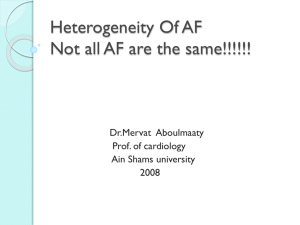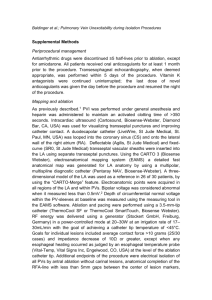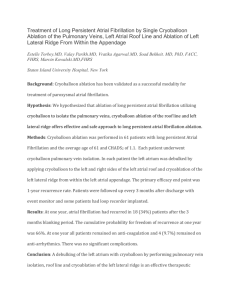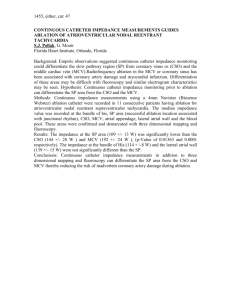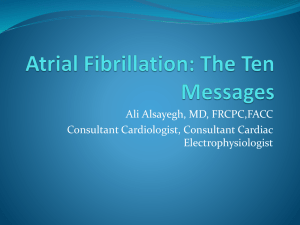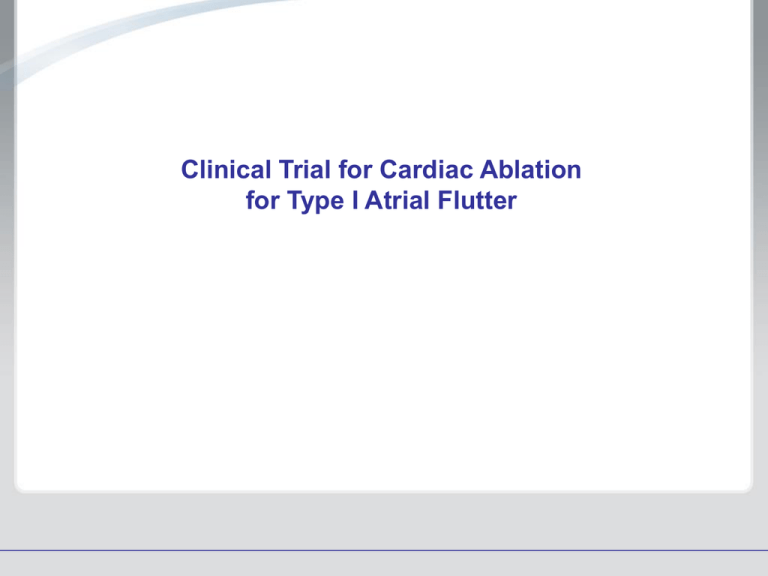
Clinical Trial for Cardiac Ablation
for Type I Atrial Flutter
DISCLAIMER
Boston Scientific Education and Presentation Resources
•
Boston Scientific develops, manufactures and markets a broad array of products and services that enable lessinvasive care for some of the most threatening cardiac conditions. Its prescription devices for use by healthcare
professionals are regulated by government agencies in each of the countries in which it does business, such as the
Food and Drug Administration in the United States (U.S.) or the Ministry of Health in Japan. These regulations often
restrict the use of the information that can be disclosed to the public. If the format of the material presented is
altered, the appropriate indications, contraindications, precautions, warnings and adverse events should be included.
•
This Presentation has been developed as a service of Boston Scientific. Like any other service, in spite of our best
efforts the information in this Presentation may become out of date over time. Nothing on this Presentation should be
construed as the giving of advice or the making of a recommendation and it should not be relied on as the basis for
any decision or action. The materials on this Web Site are intended for educational purposes only. Boston Scientific
accepts no liability for the accuracy or completeness or use of, nor any liability to update, the information contained
on this Presentation. These materials are provided "AS IS" WITHOUT WARRANTY OF ANY KIND, EITHER
EXPRESSED OR IMPLIED, INCLUDING, BUT NOT LIMITED TO, THE IMPLIED WARRANTIES OF
MERCHANTABILITY, FITNESS FOR A PARTICULAR PURPOSE, OR NON-INFRINGEMENT. Some jurisdictions do
not allow the exclusion of implied warranties, so the above exclusion may not apply to you.
Copyright and Intellectual Property
•
Boston Scientific hereby authorizes you to copy materials published by it on the Cardiac Rhythm Resources Web
Site for non commercial use only, provided any copy of these materials which you make shall retain all copyright and
other proprietary notices and any disclaimer contained thereon and on this Web Site.
•
Nothing contained herein shall be construed as conferring by implication or otherwise any license or right under any
patent or trademark of Boston Scientific or any third party. Except as expressly provided above, nothing contained
herein shall be construed as conferring any license or right under any Boston Scientific copyright.
Illustrations with the mark ©medmovie.com, are Copyright medmovie.com with all rights reserved.
Blazer II XP™ Temperature Ablation Catheter
Clinical Trial for Cardiac Ablation
for Type I Atrial Flutter
Status: Approved in 2003
First clinical trial to prove the safety and
effectiveness of 8- and 10-mm-tip ablation
catheters used with a 100 W cardiac ablation
system for the treatment of type 1 atrial flutter
Design*
Prospective, multicenter, single-arm study using objective performance criteria and
historical control data from the medical literature
Eligible patients had sustained or recurrent type 1 atrial flutter
Procedural success was defined as complete bidirectional isthmus block with
noninducible type 1 atrial flutter with only the use of the Blazer II XP™ Catheter and
EPT-1000XP™ Cardiac Ablation System and accessories
Chronic success was demonstration of acute procedural success and continued
absence of targeted type 1 atrial flutter for 6 months after the ablation procedure
Procedural safety was the absence of serious complications associated with the use of
the Blazer II XP Catheter and EPT-1000XP System within 7 days of the ablation
procedure
Clinical follow-up was performed at 1, 3, and 6 months, and at 1 and 2 years following
the procedure
* Summary of Safety and Effectiveness Data. Blazer II XP™ Cardiac Ablation Catheter, Boston Scientific Corporation, 2003. Data can be found at:
http://www.fda.gov/ohrms/dockets. Enter product name into search field.
Patient Population*
• Eligible study participants included both male and female patients
over 18 years of age that had experienced ≥2 documented episodes
of atrial flutter (by ECG, Holter, rhythm strip or ICD) within 6 months
prior to enrollment or who had ≥1 documented episodes of atrial
flutter (ECG, Holter, rhythm strip, or ICD) during the 6 months
preceding study enrollment. Some of the exclusion criteria were:
– Patients with a direct remedial cause of atrial flutter (e.g., thyroid disease,
pericarditis, pulmonary embolic disease)
– Patients with any prior isthmus cardiac ablation for type 1 AFL
– Patients in treatment for non-atrial flutter (type 1) arrhythmias with antiarrhythmic drugs (class IA, IC, or III) within three months preceding study entry
– Patients who received cardiac ablation or cardioversion for other types of nonatrial flutter (type 1) arrhythmias within 3 months preceding study entry.
• 23 US centers
• 250 patients enrolled
* Summary of Safety and Effectiveness Data. Blazer II XP™ Cardiac Ablation Catheter, Boston Scientific Corporation, 2003. Data can be found at:
http://www.fda.gov/ohrms/dockets. Enter product name into search field.
Clinical Relevance*
• To evaluate the safety and effectiveness of largetip catheter ablation in patients with type 1 atrial
flutter
• The primary endpoints were acute procedural
success, chronic (6 month) success, and
complication rate per Bayesian analysis
• First trial to demonstrate the safety and
effectiveness of 8- and 10-mm tip catheters used
with a 100 W system for the treatment of type 1
atrial flutter
* Summary of Safety and Effectiveness Data. Blazer II XP™ Cardiac Ablation Catheter, Boston Scientific Corporation, 2003. Data can be found at:
http://www.fda.gov/ohrms/dockets. Enter product name into search field.
Results
1 Summary of Safety and Effectiveness Data. Blazer II XP™ Cardiac Ablation Catheter, Boston Scientific Corporation, 2003. Data can be found at:
http://www.fda.gov/ohrms/dockets. Enter product name into search field
2 Of the 235 acute success patients, 84 patients were not included in the follow-up: 30 patients had not completed their 6-month follow-up at the time the Summary of
Safety and Effectiveness Data was reported to the FDA, and 54 were not considered due to: persistent atrial fibrillation (1), death (5), withdrawal or lost to follow-up (6),
implanted pacemakers or defibrillators (11), and treatment with Class IA, IC, or III antiarrhythmic drugs (31).
3 Patients who reached 6-month follow-up and were not on class IA, IC, or III antiarrhythmic drugs.
4 Total procedure time defined as the time of first diagnostic catheter insertion until the last diagnostic catheter withdrawal (Source: BSCI/EP Technologies US Atrial
Flutter Study Procedure Logistics Form, Rev G – 7/12/2001 – PROCLOG2).
Additional References
Feld G, Wharton M, Plumb V, Daoud E, Friehling T,
Epstein L, for the EPT-1000 XP Cardiac Ablation
System Investigators. Radiofrequency catheter
ablation of type 1 atrial flutter using large-tip 8- or 10mm electrode catheters and a high-output
radiofrequency energy generator: Results of a
multicenter safety and efficacy study. J Am Coll
Cardiol 2004; 43:1466-1472.


